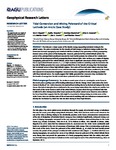Tidal Conversion and Mixing Poleward of the Critical Latitude (an Arctic Case Study)
| dc.contributor.author | Rippeth, TP | |
| dc.contributor.author | Vlasenko, V | |
| dc.contributor.author | Stashchuk, N | |
| dc.contributor.author | Scannell, BD | |
| dc.contributor.author | Green, JAM | |
| dc.contributor.author | Lincoln, BJ | |
| dc.contributor.author | Bacon, S | |
| dc.date.accessioned | 2018-01-12T10:30:23Z | |
| dc.date.available | 2018-01-12T10:30:23Z | |
| dc.date.issued | 2017-12-26 | |
| dc.identifier.issn | 0094-8276 | |
| dc.identifier.issn | 1944-8007 | |
| dc.identifier.uri | http://hdl.handle.net/10026.1/10564 | |
| dc.description.abstract |
©2017. American Geophysical Union. The tides are a major source of the kinetic energy supporting turbulent mixing in the global oceans. The prime mechanism for the transfer of tidal energy to turbulent mixing results from the interaction between topography and stratified tidal flow, leading to the generation of freely propagating internal waves at the period of the forcing tide. However, poleward of the critical latitude (where the period of the principal tidal constituent exceeds the local inertial period), the action of the Coriolis force precludes the development of freely propagating linear internal tides. Here we focus on a region of sloping topography, poleward of the critical latitude, where there is significant conversion of tidal energy and the flow is supercritical (Froude number, Fr > 1). A high-resolution nonlinear modeling study demonstrates the key role of tidally generated lee waves and supercritical flow in the transfer of energy from the barotropic tide to internal waves in these high-latitude regions. Time series of flow and water column structure from the region of interest show internal waves with characteristics consistent with those predicted by the model, and concurrent microstructure dissipation measurements show significant levels of mixing associated with these internal waves. The results suggest that tidally generated lee waves are a key mechanism for the transfer of energy from the tide to turbulence poleward of the critical latitude. | |
| dc.format.extent | 12349-12357 | |
| dc.language | en | |
| dc.language.iso | en | |
| dc.publisher | American Geophysical Union | |
| dc.subject | turbulence | |
| dc.subject | mixing | |
| dc.subject | tide | |
| dc.subject | Arctic Ocean | |
| dc.title | Tidal Conversion and Mixing Poleward of the Critical Latitude (an Arctic Case Study) | |
| dc.type | journal-article | |
| dc.type | Article | |
| plymouth.author-url | https://www.webofscience.com/api/gateway?GWVersion=2&SrcApp=PARTNER_APP&SrcAuth=LinksAMR&KeyUT=WOS:000422954700037&DestLinkType=FullRecord&DestApp=ALL_WOS&UsrCustomerID=11bb513d99f797142bcfeffcc58ea008 | |
| plymouth.issue | 24 | |
| plymouth.volume | 44 | |
| plymouth.publication-status | Accepted | |
| plymouth.journal | Geophysical Research Letters | |
| dc.identifier.doi | 10.1002/2017GL075310 | |
| plymouth.organisational-group | /Plymouth | |
| plymouth.organisational-group | /Plymouth/Faculty of Science and Engineering | |
| plymouth.organisational-group | /Plymouth/Faculty of Science and Engineering/School of Biological and Marine Sciences | |
| plymouth.organisational-group | /Plymouth/REF 2021 Researchers by UoA | |
| plymouth.organisational-group | /Plymouth/REF 2021 Researchers by UoA/UoA07 Earth Systems and Environmental Sciences | |
| plymouth.organisational-group | /Plymouth/Research Groups | |
| plymouth.organisational-group | /Plymouth/Research Groups/Marine Institute | |
| plymouth.organisational-group | /Plymouth/Users by role | |
| plymouth.organisational-group | /Plymouth/Users by role/Academics | |
| dcterms.dateAccepted | 2017-12-01 | |
| dc.identifier.eissn | 1944-8007 | |
| dc.rights.embargoperiod | Not known | |
| rioxxterms.versionofrecord | 10.1002/2017GL075310 | |
| rioxxterms.licenseref.uri | http://www.rioxx.net/licenses/all-rights-reserved | |
| rioxxterms.licenseref.startdate | 2017-12-26 | |
| rioxxterms.type | Journal Article/Review |


